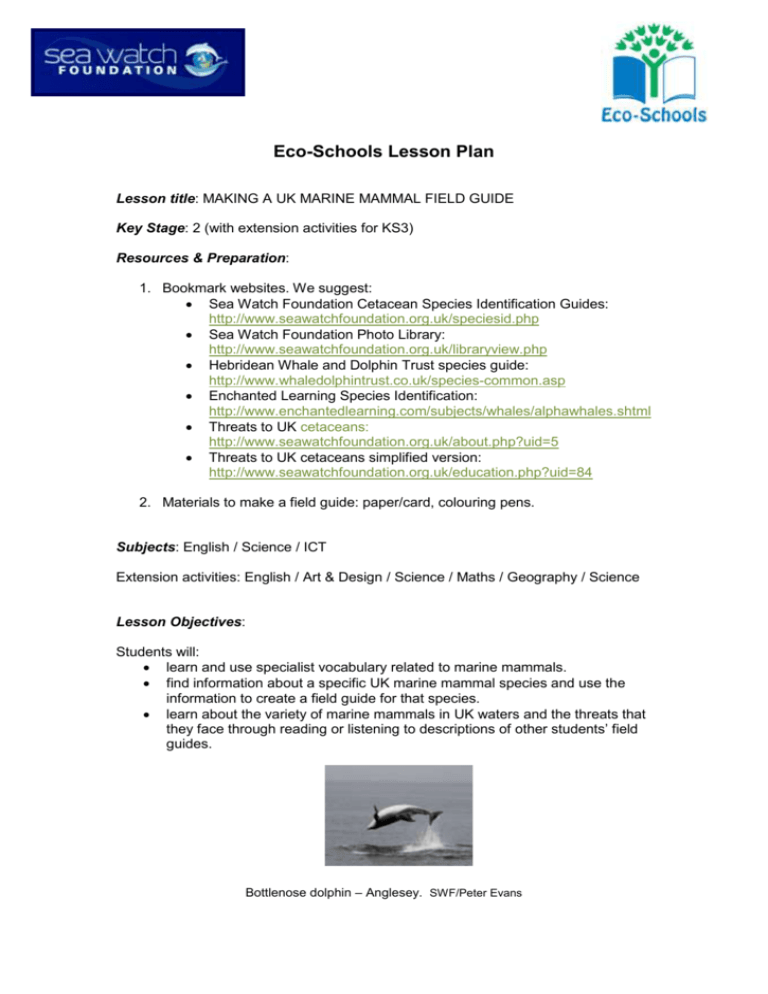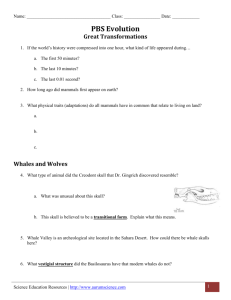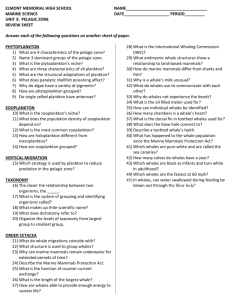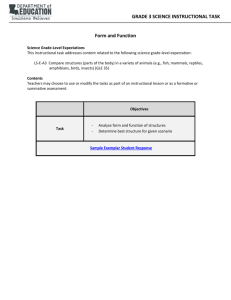Eco Schools Lesson Plan
advertisement

Eco-Schools Lesson Plan Lesson title: MAKING A UK MARINE MAMMAL FIELD GUIDE Key Stage: 2 (with extension activities for KS3) Resources & Preparation: 1. Bookmark websites. We suggest: Sea Watch Foundation Cetacean Species Identification Guides: http://www.seawatchfoundation.org.uk/speciesid.php Sea Watch Foundation Photo Library: http://www.seawatchfoundation.org.uk/libraryview.php Hebridean Whale and Dolphin Trust species guide: http://www.whaledolphintrust.co.uk/species-common.asp Enchanted Learning Species Identification: http://www.enchantedlearning.com/subjects/whales/alphawhales.shtml Threats to UK cetaceans: http://www.seawatchfoundation.org.uk/about.php?uid=5 Threats to UK cetaceans simplified version: http://www.seawatchfoundation.org.uk/education.php?uid=84 2. Materials to make a field guide: paper/card, colouring pens. Subjects: English / Science / ICT Extension activities: English / Art & Design / Science / Maths / Geography / Science Lesson Objectives: Students will: learn and use specialist vocabulary related to marine mammals. find information about a specific UK marine mammal species and use the information to create a field guide for that species. learn about the variety of marine mammals in UK waters and the threats that they face through reading or listening to descriptions of other students’ field guides. Bottlenose dolphin – Anglesey. SWF/Peter Evans Introduction The UK has over 20,000 kilometres of coast line¹. The coast includes sandy and pebbly beaches, estuaries, mudflats and high cliffs. Approximately 25% of animals that live in the UK live in its seas². UK waters are home to at least 44,000 species of plants and animals³, including corals, seahorses, seals and the world’s second biggest fish, the plankton eating basking shark. They are summer feeding grounds for whales and the yearround home for dolphins and porpoises. Most species of great whale are still listed as threatened or endangered on the International Union for the Conservation of Nature and Natural Resources (IUCN) Red List4. The southern hemisphere population of blue whales – the largest animal ever to have lived on earth – has fallen from 240,000 a century ago to 1,700 now. The population of humpback whales, famous for their ‘songs’, has plummeted from 115,000 to 25,000. There are only about 30 female western gray whales capable of breeding left and other species have such low populations that they too are endangered5. Although it is not well-known, 27 species of whales, dolphins and porpoises (cetaceans) have been observed in UK waters. All whales, dolphins and porpoises are fully protected in UK and EU waters6. White-beaked dolphins. SWF/Peter Evans Activities (lesson plan): 1. Create interest in the topic of marine mammals. Play some marine mammal calls. Sound recordings are available at the bottom of the page of each Species Identification Guide on the Sea Watch website (listed in the Resources section). Ask the students to guess what kind of animals they are. Alternatively, show students some pictures or photos of marine mammals and ask whether they have seen such animals and, if so, where. 2. Introduce specialist vocabulary. Students match the terms with the correct definitions (Worksheet A). The activity can be done individually or in groups. Once completed, in pairs the students can test each other, one reading out the definitions and the other guessing the answer. 3. Find out how much students know about marine mammals. Give the students a quiz to discuss and answer in small groups (Worksheet B). Alternatively, one side of the classroom can be designated as True and the opposite side False. The teacher reads out a sentence from the quiz and the students go to the wall they think is correct. 4. Introduce basic anatomy of dolphins and whales. Students label the anatomy of dolphins (Worksheet C) to familiarise themselves with the basic features of cetaceans before compiling a field guide. This can be done individually. Alternatively, a large dolphin can be drawn on the board or a large drawing/collage made and then labelled with suggestions from the whole class. Ask the students about the features of dolphins that are adaptations to its marine habitat, for example, the position of blowhole, its sleek and streamlined shape, the thick blubber to keep warm. 5. Students create a field guide. Individually, or in small groups, students are assigned a particular species of marine mammal to research about and create a ‘field guide’ on. The species should be one that can be seen in UK waters (see Appendix). The field guide should include: a drawing or picture of the animal; its scientific (Latin) name; its size; basic facts about its life cycle – life-expectancy, length of gestation; basic facts about its habitat and diet – what does it eat, what eats it?; population and distribution; the conservation challenges it faces. The layout can be in the form of questions, e.g. what species is it? Where does it live? How long does it live? The guides can be handwritten pamphlets, simple A4 sheets folded in half to make a 4-page ‘mini-book’, or used as a way of practising ICT skills. Alternatively, the guides could be done in the form of a ‘report wheel’ which reveals one piece of information at a time. For different report wheel designs take a look at the Enchanted Learning website7. Older students can research the required information by looking at the Sea Watch Foundation or Hebridean Whale and Dolphin Trust websites listed in the Resources section. Younger students can use the species profiles on the Enchanted Learning website. 6. Students teach each other about marine mammals. The field guides can be put on display for the rest of the class or school to read. In addition, the students can talk about their field guides in small groups to develop communication skills and to compare and contrast the species covered. Harp Seals. SWF/Peter Evans Extension activities: Measuring sizes of cetaceans. Students can practise doing scale drawings of cetaceans and carry out a numeracy investigation to consider the relationship between size of cetacean and the maximum time they can hold their breath for8. [Maths / Science] Write a poem - Students can read marine-related poems and then write their own poems in free verse or practise a particular poetry form, for example, haiku9. The students could listen to ‘whale music’ as inspiration. [English] Listen to or read a marine mammal related story – Below is a list of some popular children’s books: Witi Ihimaera - The Whale Rider (KS2/KS3) Michael Morpurgo – This morning I met a whale (KS2) Michael Morpurgo – Why the whales came (KS2) Dyan Sheldon & Gary Blythe – The Whale’s Song (KS2) [English] Write a story - Students imagine themselves as a marine mammal and write a story about “A day in the life of a …. [whale, seal, etc]” [English] Write and perform a play – Students imagine themselves as whales or other sea mammals. It could be a situation of conflict between dolphins and fishermen or whales being watched by human ‘whale-watchers’. [English] Complete and create a crossword – Students can complete a dolphinrelated crossword10. Afterwards, the students can create their own crossword on the theme of whales, marine mammals or marine life in general to be completed by other students. [English] Fold whale origami – Students can make simple whale origami and use them for a larger project, e.g. a mobile or poster11. Alternatively, students can fold one thousand whale origami to raise money, perhaps for adopting a dolphin or for a marine-related charity. In Japanese culture it is traditional to fold 1,000 origami cranes to bring good health or luck12. [Art & Design] For Schools near to the coast Practise marine mammal surveying. The Sea Watch Foundation coordinates the national cetacean sightings network and has regional groups around the UK that you can contact to find out when and where local voluntary surveys are taking place13. The Sea Watch website also contains information about how to carry out a survey and record and report sightings14. [Science] Grey Seal. SWF/Peter Evans Key Stage 3 Activities Creating an Identification (taxonomic) Key. Students can look at and try out examples of identification keys for wildlife they can readily observe, for example, butterflies, trees, birds. The students then use what they have learnt to create an identification key for a marine mammal. Appendix 2 shows two examples of keys developed by the Sea Watch Foundation for seaweed and shell identification. Also, the Hebridean Whale and Dolphin Trust has developed some simple classification keys for whales and dolphins for teachers to use15. Students can be encouraged to think about why classifying/identifying wildlife can be useful (if we can recognise a species, we can identify how many there are of that species, where they live and which other species they interact with in order to learn about and protect them). [Science] Researching about Marine Protected Areas. Students can do research on which areas of the UK’s coast and seas are protected and why. Marine Protected Areas in the UK include three National Marine Nature Reserves (Lundy Island in Devon; Strangford Lough in Northern Ireland; and Skomer Island in SW Wales), 72 Special Areas of Conservation to protect marine wildlife and 73 Special Protection Areas to protect birds near the coast16.Are there any Marine Protected Areas close to your school? The areas can be mapped and students can reflect on the question of which areas are not protected and why. Is there nothing worth protecting? (Unlikely). If a marine area is protected how could that affect the local economy positively and negatively? For further information see the website for the UK Marine Protected Areas Centre17. [Geography] Learn about and debate dolphin and whale-watching – Students can research and then discuss the benefits and drawbacks of dolphin and whalewatching (as a form of ecotourism) and look at famous places for whalewatching and how/if the area and animals have been affected. The Department for Environment, Food & Rural Affairs (DEFRA) has put together a report on the benefits of whale watching18. [Geography] Risso’s dolphin. SWF/Peter Evans Curriculum Links: Science Sc2 Pupils should be taught: 1(a) that life processes common to human and other animals include nutrition, movement, growth and reproduction. 4(c) that the variety of plants and animals make it important to identify them and assign them to groups; 5(a) about ways in which living things and the environment need protection; (b) about the different plants and animals found in different habitats. Breadth of Study 2(a) use appropriate scientific language and terms … to communicate ideas and explain the behaviour of living things. English En1 Speaking To speak with confidence in a range of contexts, adapting their speech for a range of purposes and audiences, pupils should be taught to: 1(a) use vocabulary and syntax that enables them to communicate more complex meanings. Breadth of Study The range of speaking should include: 8(b) presenting to different audiences. (c) extended speaking for different purposes. En2 Reading Reading for information – pupils should be taught to: 3(a) scan texts to find information; (c) obtain specific information through detailed reading. Breadth of Study – Non-fiction and non-literary texts The range should include: 9(b) print and ICT-based reference and information materials. En3 Writing To develop their writing on paper and on screen, pupils should be taught to: 2(a) plan – note and develop initial ideas; (b) draft – develop ideas from the plan into structured written text; (c) revise – change and improve the draft; (d) proofread – check the draft for spelling and punctuation errors, omissions and repetitions; (e) present – prepare a neat, correct and clear final copy. Information & Computer Technology (ICT) [if used] Pupils should be taught: 1(a) to talk about what information they need and how they can find and use it; (b) how to prepare information for development using ICT, including selecting suitable sources finding information, classifying it and checking it for accuracy; 3(a) how to share and exchange information in a variety of forms, including e-mail; (b) to be sensitive to the needs of the audience and think carefully about the content and quality when communicating information. 4(a) review what they and others have done to help them develop their ideas; (b) describe and talk about the effectiveness of their work with ICT, comparing it with other methods and considering the effect it has on others; (c) talk about how they could improve future work. Sources ¹ http://www.bbc.co.uk ² http://www.bbc.co.uk ³ http://www.wildlifewatch.org.uk/Explore-wildlife/Habitats/Marine 4 http://www.iucnredlist.org/ 5 http://www.defra.gov.uk/wildlife-pets/whales-dolphins/ 6 http://www.defra.gov.uk/wildlife-pets/whales-dolphins/ 7 http://www.enchantedlearning.com/wordwheels/animals/report/ 8 http://www.seawatchfoundation.org.uk/education.php?uid=84 9 http://www.northcanton.sparcc.org/~ptk1nc/whaletales/dunn/dunn.html 10 http://www.dolphinkind.com/crossword.html 11 http://www.enchantedlearning.com/crafts/origami/whale/ . For a more complex version of the origami whale, watch the ‘youtube’ video: http://www.youtube.com/watch?v=OGoTSVFCSe0&feature=youtu.be 12 http://en.wikipedia.org/wiki/Thousand_origami_cranes 13 http://www.seawatchfoundation.org.uk/observing.php?uid=18 14 http://www.seawatchfoundation.org.uk/sightings.php?uid=29 15 http://www.whaledolphintrust.co.uk/education-secondary.asp?library_id=25 16 http://www.mcsuk.org/ 17 http://www.ukmpas.org/ 18 http://www.defra.gov.uk/wildlife-pets/whales-dolphins/ Appendix 1 – List of Marine Mammals recorded in UK waters (* = vagrant; a species that occurs extremely rarely as the region does not form part of its usual range) *Beluga whale (Delphinapterus leucas) *Blainwille’s beaked whale (Mesoplodon densirostris) Blue whale (Balaenoptera musculus) Cuvier’s beaked whale (Ziphius cavirostris) *False killer whale (Pseudorca crassidens) Fin whale (Balaenoptera physalus) *Gervais’ beaked whale (Mesoplodon europaeus) Humpback whale (Megaptera novaeangliae) Killer whale / Orca (Orcinus orca) Long-finned pilot whale (Globicephala melas) *Melon-headed whale (Peponocephala electra) Minke whale (Balaenoptera acutorostrata) *Narwhal (Monodon monoceros) *North Atlantic right whale (Eubalaena glacialis) Northern bottlenose whale (Hyperoodon ampullatus) *Pygmy sperm whale (Kogia breviceps) Sei whale (Balaenoptera borealis) Sowerby’s beaked whale (Mesoplodon bidens) Sperm whale (Physeter macrocephalus) Atlantic white-sided dolphin (Lagenorhynchus acutus) Bottlenose dolphin (Tursiops truncatus) Common dolphin (Delphinus delphis) *Fraser’s dolphin (Lagenodelphis hosei) Risso’s dolphin (Grampus griseus) Striped dolphin (Stenella coeruleoalba) White-beaked dolphin (Lagenorhynchus albirostris) Harbour porpoise (Phocoena phocoena) *Bearded seal (Erignathus barbatus) Common (Harbour) seal (Phoca vitulina) Grey seal (Halichoerus grypus) *Harp seal (Pagophilus groenlandica) *Hooded seal (Cystophora cristata) *Ringed seal (Pusa hispida) *Walrus (Odobenus rosmarus) Appendix 2 – Example Identification (taxonomic) keys – seaweed and shells – created by the Sea Watch Foundation. Worksheet A – Useful words to talk about marine mammals Match the vocabulary in the box with the correct definition. baleen cetaceans blowhole dorsal fin blubber marine mammals dolphins echolocation mammal pod 1. _________________ = A warm-blooded animal (the inside temperature stays about the same) often covered in hair that usually gives birth to live young and feeds its young with milk. 2. _________________ = Mammals that live in the sea and breathe air, for example, seals, sea otters, whales and dolphins. 3. _________________ = Dolphins, porpoises and whales. 4. _________________ = Small cetaceans often with a long snout. They are Odontoceti (toothed whales). 5. _________________ = The fin on an animal’s back. 6. _________________ = A thick layer of fat which helps an animal to keep its temperature stable, to store food energy and help the animal to float (fat is lighter than air). 7. ________________ = Toothed whales use this to find objects under water. The whale sends out high-pitched sounds (clicks) which bounce off objects. The whale uses this “returning echo” to find out the object’s shape, direction, texture and distance. 8. ________________ = This is the whale’s nostril. It is found on the top or back of the head and whales breathe air through it. Odontoceti (toothed whales) have one and Mysticeti (baleen whales) have two. 9. ________________ = This hangs from the upper jaw of some whales. The whales use it to filter the water for food (krill and small fish). It is made of keratin, the same as our fingernails. 10. ______________= A group of whales or dolphins. (Definitions based on the Whale Glossary: http://www.enchantedlearning.com ) Worksheet A - Answers Answers: 1. mammal; 2. marine mammal; 3. cetaceans; 4. dolphins; 5. dorsal fin; 6. blubber; 7. echolocation; 8. blowhole; 9. baleen; 10. pod Worksheet B – Marine Mammal Quiz True or False? 1. Dolphins have teeth. 2. A porpoise is a kind of fish. 3. Some whales lay eggs. 4. Whales cannot breathe underwater. 5. Dolphins swim by moving their tail (fluke) from left to right. 6. You can see over 25 species of dolphin, porpoise and whale in the seas around the United Kingdom. 7. Dolphins usually live alone. 8. Dolphins sleep more than 20 hours a day. 9. A baby dolphin is called a pup. 10. Dolphins can get sunburned. 11. All whales are huge. 12. A seal spends all its life in water. ANSWERS with explanatory notes Although some of the information below is rather detailed it may help with any questions that come up during a class on marine mammals. 1. Dolphins have teeth. TRUE All dolphins are toothed whales belonging to the sub-order, Odontoceti, referred to as odontocetes, of the order Cetacea. As a group, dolphins are often referred to as "small" cetaceans, even though some of them are quite large, attaining lengths of over 20 feet (6 metres). Dolphins belong to the family Delphinidae. Dolphins possess a distinct beak. Their teeth are conical in shape. Most species of dolphins are larger than porpoises, with the males usually being larger than the females. Source: (adapted from) http://www.earthtrust.org/wlcurric/dolphins.html The family Delphinidae is the most diverse of the cetacean order and comprises 36 living species. Source: Perrin, W.F. (2009). World Cetacea Database. Available online at http://www.marinespecies.org/cetacea. Consulted on 2011-07-10. 2. A porpoise is a kind of fish. FALSE Although the terms dolphins and porpoises are often used interchangeably, they really refer to two different types of animals. Porpoises belong to the family Phocoenidae. They are generally smaller than dolphins. Most attain about 1.5 – 2 metres in length. Porpoises have no distinct beak, or rostrum. The forehead slopes almost uniformly to the tip of their snout, and their teeth are spade-like in shape. Source: (adapted from) http://www.earthtrust.org/wlcurric/dolphins.html The family Phocoenidae consists of only seven members. Source: Perrin, W.F. (2009). World Cetacea Database. Available online at http://www.marinespecies.org/cetacea. Consulted on 2011-07-10. 3. Some whales lay eggs. FALSE All whales are mammals. 4. Whales cannot breathe underwater. TRUE Whales can remain underwater for long periods of time relative to humans. Sperm whales are the deepest divers and have been known to dive for 1-2 hours without resurfacing. However, all marine mammals must re-surface to get more oxygen. Marine mammals have evolved to conserve oxygen by lowering their heart rate and are able to store oxygen by having higher concentrations of it in their blood. In long dives the blood is re-circulated only to vital organs. Source: http://www.whaletimes.org 5. Dolphins swim by moving their tail (fluke) from left to right. FALSE Dolphins swim by moving their fluke up and down. Fish move their tail from left to right. 6. You can see over 25 species of dolphin, porpoise and whale in the seas around the United Kingdom. TRUE You may have to travel to the far corners of the UK, from the Scilly Isles to the Shetland Islands, but 27 species of cetaceans have been recorded in UK waters. 7. Dolphins usually live alone. FALSE Dolphins are sociable animals. Although adult males in particular may sometimes feed by themselves, dolphins generally live in small groups (pods). 8. Dolphins sleep more than 20 hours a day. FALSE Dolphins are thought to sleep about 8 hours a day. However, their way of sleeping is different to ours: While sleeping, the bottlenose dolphin shuts down only half of its brain, along with the opposite eye. The other half of the brain stays awake at a low level of alertness. This attentive side is used to watch for predators, obstacles and other animals. It also signals when to rise to the surface for a fresh breath of air. After approximately two hours, the animal will reverse this process, resting the active side of the brain and awaking the rested half. This pattern is often called cat-napping. Source: http://www.scientificamerican.com/article.cfm?id=how-do-whales-and-dolphin 9. A baby dolphin is called a pup. FALSE It is a calf. A baby seal is called a pup. 10. Dolphins can get sunburned. TRUE A dolphin’s skin can indeed get burnt and blistered by the sun. 11. All whales are huge. FALSE There are plenty of small and medium-sized whales. The smallest whale is the dwarf sperm whale, which is 8.5 feet long (2.6 m). Source: http://www.enchantedlearning.com 12. A seal spends all its life in water. FALSE Seals are adapted to spending time, sometimes days, out of the water. Seals are pinnipeds, which is the order of marine mammals including seals, sea lions and walruses. All are characterized by having large eyes, prominent snouts, streamlined shapes and four swimming flippers which typify the order. In fact, the word pinniped means "feather-" or "fin-footed" in Latin. Although they have successfully adapted to life in the sea, pinnipeds are thought to have evolved from terrestrial mammals about 20 million years ago and continue to retain strong ties to land. Their closest modern day terrestrial ancestors are the bear and the dog. Pinnipeds can be divided into three distinct families; 1) the Phocidae which are the "true," or earless seals 2) the Otariidae, the eared seals and sea lions, and 3) the Odobenidae, which includes only the walrus. Source: http://www.earthtrust.org/wlcurric/seals.html#anchor504434 There are thought to be 36 different species of pinnipeds. Source: Perrin, W.F, Wursig, B & Thewissen, J.G.M (eds) (2009) Encyclopaedia of Marine Mammals. Worksheet C Dolphin Anatomy – Label me! Read the definitions, then label the dolphin diagram below. beak - the elongated part of the mouth and jaws fluke - one half of the tail flipper - one of a pair of wide, flat blowhole - the hole on the top of the head forelimbs that is used for swimming through which the dolphin breathes air (it is the dolphin's nostril) median notch - the indentation between the two flukes dorsal fin - the fin on the upper side of the body melon - the rounded structure in the top of the dolphin's head just in front ear - hearing organs located on the head of the blowhole behind the eye eye - sight organs located on the head Source: http://www.enchantedlearning.com/subjects/whales/label/labeldolphin.shtml Worksheet C – Answers








